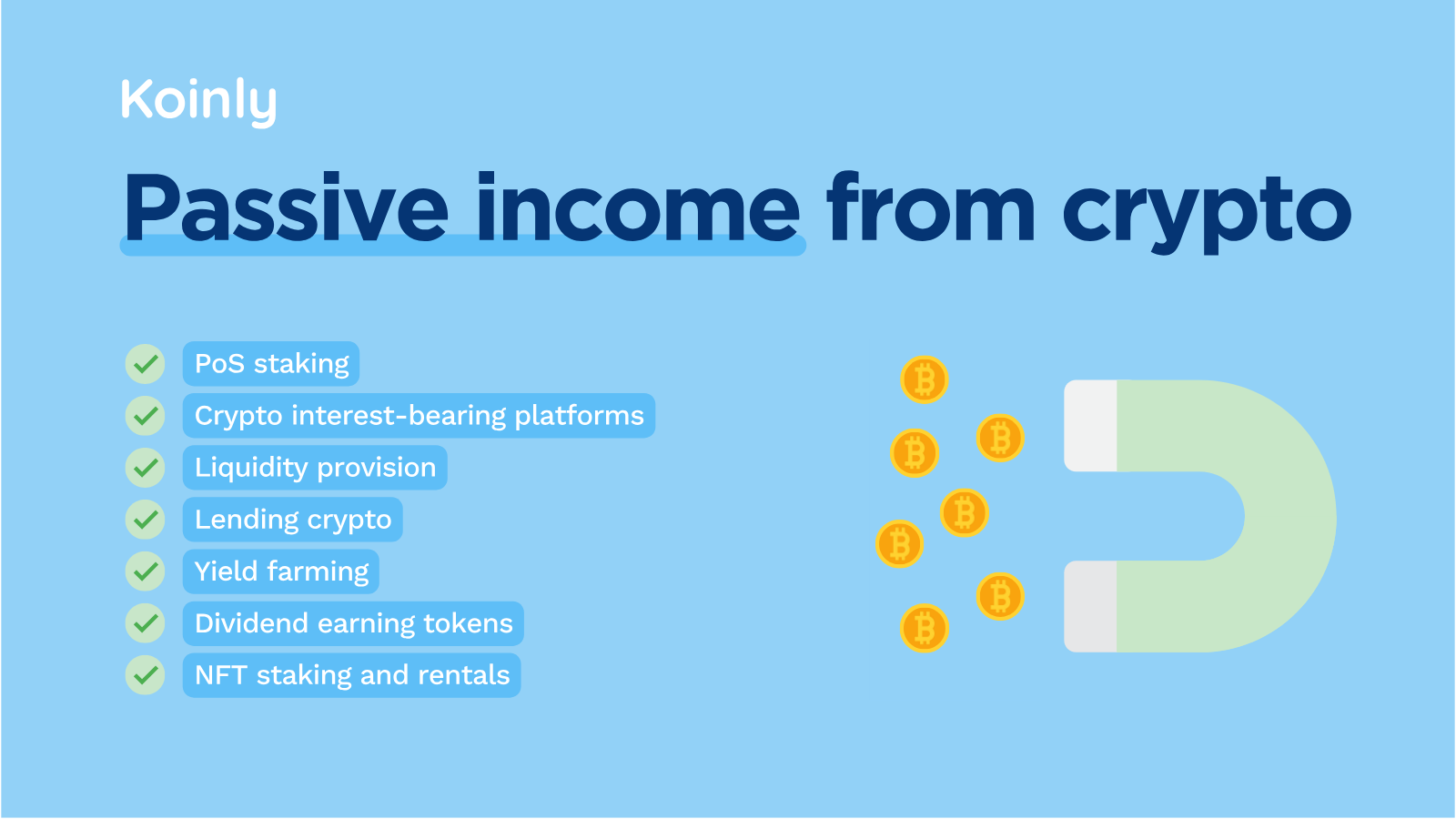How to Invest in Cryptocurrency for Passive Income in 2024
How to Invest in Cryptocurrency for Passive Income in 2024

You’ve probably heard the term “passive income” thrown around in the world of finance and investing. Everyone’s looking for ways to make money while they sleep, right? But did you know that the cryptocurrency market offers a variety of ways to generate passive income in 2024? Whether you’re a seasoned crypto investor or just getting started, there are ways to earn consistent returns without having to constantly monitor the markets.
But here’s the catch: not all passive income methods are created equal. Some carry higher risks, while others offer steady, reliable returns. So, how do you choose the best strategies that suit your risk tolerance and financial goals? Let’s explore how you can safely invest in cryptocurrency for passive income in 2024, with low-risk strategies for consistent returns.
The Problem: Cryptocurrency Isn’t Just About Trading
When people think of making money in crypto, they usually think of day trading or buying and holding (HODLing) until their coins skyrocket in value. But trading is risky, especially with crypto’s notorious volatility. Plus, actively managing your portfolio can be time-consuming and stressful.
But what if you didn’t have to trade constantly? What if there were ways to earn income from your crypto without needing to sell your assets or time the market perfectly? That’s where passive income methods come in.
Key Methods for Generating Passive Income with Cryptocurrency

So, how exactly can you earn passive income with crypto? Let’s dive into some of the most popular methods, from low-risk options to higher-yield strategies.
1. Staking Cryptocurrency: Earn While You Hold
Crypto staking is one of the most popular and relatively low-risk ways to generate passive income. But what exactly is staking?
How It Works:
Staking involves locking up your cryptocurrency in a blockchain network to help validate transactions. In return, you earn rewards, similar to earning interest on a savings account. This is possible with Proof of Stake (PoS) and Delegated Proof of Stake (DPoS) blockchains, where validators are chosen to confirm transactions and create new blocks based on how much crypto they have staked.
Example:
Some popular cryptocurrencies that allow staking include:
- Ethereum (ETH): After transitioning to Proof of Stake, Ethereum now offers staking rewards for users who lock up their ETH.
- Cardano (ADA): Offers consistent staking rewards with relatively low risk.
- Solana (SOL): A high-performance blockchain that provides attractive staking rewards.
Tip:
If you’re looking for stable returns, staking can be a great way to earn passive income while holding onto your crypto for the long term. However, the amount you earn depends on the network’s staking rewards, which can fluctuate.
2. Yield Farming: High Rewards, Higher Risk
Yield farming is another method to generate passive income, but it’s definitely not for the faint-hearted. This process involves lending your crypto assets to a decentralized finance (DeFi) platform, where they can be used for liquidity. In exchange, you earn interest, usually paid in the platform’s native token.
How It Works:
Yield farming often involves providing liquidity to decentralized exchanges (DEXs) like Uniswap or PancakeSwap. You lock your assets into liquidity pools, and the platform rewards you with tokens that you can either reinvest or sell for a profit.
Example:
- PancakeSwap: A Binance Smart Chain-based DEX that allows you to farm CAKE tokens by providing liquidity to the platform.
- Aave and Compound: These DeFi platforms offer interest on crypto assets that are loaned out to other users, providing steady returns.
The Risk:
Yield farming often offers higher returns, but it comes with higher risks. Liquidity pools can suffer from impermanent loss, and there’s always the possibility of smart contract exploits. So, while the potential rewards are significant, the risks can be just as high.
3. Crypto Lending: Earn Interest with Minimal Effort
If staking and yield farming feel too complex, crypto lending might be more your speed. This involves lending your cryptocurrency to borrowers through centralized platforms like BlockFi, Nexo, or Celsius, or through decentralized platforms like Compound or Aave. In return, you earn interest on your lent assets.
How It Works:
When you lend your crypto, borrowers use your funds, and in exchange, you earn interest. Interest rates vary depending on the platform and the type of crypto you’re lending, but they can often range from 4% to 12% annually.
Example:
- BlockFi: A popular platform for crypto lending, offering interest rates for stablecoins like USDC and mainstream cryptos like Bitcoin and Ethereum.
- Aave: A decentralized protocol where you can lend your assets and earn interest directly from other users without an intermediary.
Why It’s Low Risk:
Crypto lending, especially through centralized platforms, is considered a lower-risk passive income method compared to yield farming or staking. However, there’s still the risk of the platform facing liquidity issues or, in the case of decentralized platforms, smart contract vulnerabilities.
4. Earning Dividends with Crypto Stocks or ETFs
If you’re looking for a safer way to earn passive income without directly holding cryptocurrencies, investing in crypto stocks or ETFs could be an excellent choice. These financial products allow you to gain exposure to the crypto market without the volatility that comes with directly owning coins.
Example:
- Grayscale Bitcoin Trust (GBTC): This trust allows investors to buy shares that track the price of Bitcoin, offering indirect exposure to the crypto market.
- Purpose Bitcoin ETF (BTCC): The first Bitcoin ETF in North America, designed for investors who want exposure to Bitcoin without needing to own it directly.
The Benefit:
Crypto ETFs and stocks allow you to earn dividends while still benefiting from crypto’s growth, but with lower risk. You won’t earn staking rewards or interest, but your stock or ETF may pay out regular dividends, which can be a stable source of passive income.
5. Running a Crypto Masternode
Running a masternode is another way to earn passive income in the crypto space, although this method requires a significant initial investment. A masternode is essentially a dedicated server that helps maintain a blockchain’s network. In exchange for validating transactions and securing the network, you earn rewards.
Example:
- Dash: One of the most popular cryptocurrencies for masternode operators, Dash allows users to run nodes and earn rewards.
- PIVX: Another cryptocurrency that offers masternode rewards for network validators.
The Catch:
Setting up a masternode typically requires a large number of coins to be locked up as collateral, which can be costly. It’s a more advanced strategy and carries the risk of losing your collateral if the value of the crypto drops.
The Climax: Choosing the Right Strategy for Passive Income
At this point, you might be wondering, which method is best for me? The answer depends on your risk tolerance, how much time you’re willing to invest in managing your portfolio, and your financial goals. Here’s a quick rundown:
- If you want low-risk, stable returns, staking or crypto lending might be your best bet.
- If you’re after higher returns and are willing to take on more risk, yield farming or running a masternode could provide greater rewards.
- For those looking for indirect exposure to crypto, investing in crypto ETFs or dividend-paying stocks offers a balance of safety and profit.
Conclusion: How to Start Generating Passive Income with Crypto in 2024

The crypto world isn’t just for traders and tech enthusiasts—it’s for anyone looking to build a diverse portfolio that includes passive income. Whether through staking, yield farming, crypto lending, or investing in ETFs, there are plenty of ways to earn consistent returns in 2024 without having to manage your portfolio daily. The key is to start small, do your research, and choose the strategies that best fit your financial situation and risk tolerance.
Want more tips on how to invest smartly in cryptocurrency? Subscribe for more guides on building wealth with crypto.
comments powered by Disqus